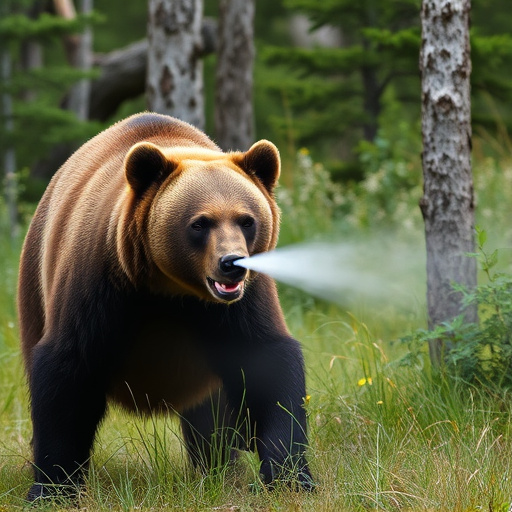Grizzly bears can be unpredictable despite their solitary nature, so understanding their behavior and carrying bear spray is crucial for safe outdoor activities in their habitat. Bear spray remains effective even in cold temperatures, but its performance may slightly diminish due to reduced pressure. Proper storage away from direct sunlight and extreme heat, along with regular expiration checks, ensures optimal performance. Key safety measures include recognizing aggression cues, traveling in groups, securely storing food, backing away slowly if charged, using noise and visual deterrents, and deploying bear spray at 20-30 feet to distract the bear.
In the vast wilderness, encountering a grizzly bear can be a terrifying prospect. Understanding their behavior and preparing for potential attacks is crucial for outdoor enthusiasts and survivalists alike. This article explores effective strategies to defend against aggressive bears, focusing on bear spray as a key tool. We delve into the science behind bear aggression, the performance of bear spray in various conditions, including its efficacy in cold temperatures, and essential tips for safe wilderness encounters. Learn how to store bear spray properly, ensuring it’s ready when facing a dangerous situation.
- Understanding Grizzly Bear Behavior: What Triggers Aggression?
- The Efficacy of Bear Spray: Does Temperature Impact Its Performance?
- Wilderness Safety Tips: Preparing for Encounters and Effective Defense Mechanisms
- Storing Bear Spray: Ensuring Readiness When You Need It Most
Understanding Grizzly Bear Behavior: What Triggers Aggression?
Grizzly bears, known for their immense strength and ferocity, can be unpredictable creatures. Understanding their behavior is crucial when venturing into their habitat. These powerful animals are typically solitary and prefer to avoid human interaction. However, certain factors can trigger aggression, making it essential for outdoor enthusiasts to be aware of these cues.
Bear spray, a common defense tool, is effective against grizzlies, but its performance depends on temperature. Extreme cold can cause the spray to freeze in the canister, reducing its effectiveness. Therefore, proper storage and preparation are vital. Knowing how to recognize signs of aggression, such as huffing, clacking teeth, or standing on hind legs, can help hikers make quick decisions to ensure their safety when facing a charging bear.
The Efficacy of Bear Spray: Does Temperature Impact Its Performance?
Bear spray, also known as bear repellent, has long been a go-to defense mechanism for outdoor enthusiasts navigating wild territories. Its efficacy against charging grizzly bears is well documented, offering a non-lethal way to deter an attack. However, one common concern among users is the impact of temperature on its performance. Can bear spray freeze in storage or during use, rendering it ineffective?
The short answer is that while cold temperatures can affect bear spray’s performance, it is unlikely to freeze under normal conditions. Bear spray is designed to be weather-resistant and usually comes with instructions for proper storage and usage. During cold weather activities, it’s recommended to keep the spray in a warm pocket or container to maintain its optimal performance. In extreme cold, some users report that the spray might become slightly less effective due to the reduced pressure from the can, but it will not freeze solid. This is unlike other liquid repellents that can indeed freeze and lose their potency.
Wilderness Safety Tips: Preparing for Encounters and Effective Defense Mechanisms
When venturing into bear country, preparation is key. Before entering the wilderness, familiarize yourself with local guidelines and bear behavior patterns. Always travel in groups and make noise to avoid unexpected encounters. Keep food securely stored and carry bear spray as a last resort defense mechanism. It’s important to note that bear spray can be affected by extreme cold, so ensure it remains above freezing temperatures during storage for optimal performance when needed.
Should a grizzly charge, remain calm and assess the situation. If possible, back away slowly while keeping eye contact with the bear. Never turn your back or run as this may trigger their predatory instincts. Use noise and visual deterrents like waving your arms to make yourself appear larger. As a last resort, deploy bear spray directly towards the bear’s face when it’s within 20-30 feet, aiming for its eyes and nose. This can create enough distraction for you to escape or seek shelter.
Storing Bear Spray: Ensuring Readiness When You Need It Most
Storing bear spray correctly is paramount to ensuring its effectiveness when encountering a grizzly. One common concern, especially in colder climates, is whether the spray will freeze during storage. However, modern bear spray containers are designed to withstand sub-freezing temperatures, so freezing isn’t typically an issue. It’s more crucial to store the spray in a secure, readily accessible location, away from direct sunlight and extreme heat. This prevents degradation of the active ingredients over time.
To be prepared for a potential encounter, keep bear spray within easy reach, ideally on your person or secured to your hiking gear. Ensure everyone in your group knows its location and how to use it. Regularly checking the spray’s expiration date and replacing it as needed is also essential, as the effectiveness of bear spray can diminish over time, regardless of storage conditions.
In defending against charging grizzly bears, understanding their behavior and utilizing effective tools like bear spray are paramount. While temperature can impact bear spray performance, proper storage practices, including preventing freezing, ensure its readiness when needed most. By combining knowledge of bear aggression triggers with key safety tips and mechanisms, individuals can enhance their wilderness protection and reduce risks during encounters in grizzly country.
